Another chance to make sure bikes count
May 11, 2010
Cyclists, your time has come. People who leave their cars at home and bicycle to the train station for the daily commute are in the Metro spotlight.
Over the next three weeks, the transit agency will be surveying and counting bicycle usage among rail passengers at 20 stations–those who park their bikes as well as those who bring their bikes onboard.
The effort started today. The names of the stations are not being released in advance in order to preserve the study’s integrity. But if you’re a bike commuter, don’t pass up this chance to roll up and be counted.
Results of the survey, to be conducted by the Los Angeles County Bicycle Coalition, will be used by a team of Metro consultants to “estimate the amount of greenhouse gases saved by bicyclists using Metro rail lines instead of driving.”
Results of another bicycle survey conducted among Orange Line riders earlier this year are being tabulated and will be released soon.
Posted 5/11/10
A big step for Valley walkers
May 7, 2010
The walking doc’s back. And in case you missed him the first time around the block, here are a couple of things he won’t be bringing with him: a pedometer and a drill master’s go-for-the-burn attitude.
In fact, Dr. Glenn A. Lopez, creator of the Walking in Community program now up and running in Sun Valley and Sylmar, thinks the “community” piece of the equation is just important as the exercise itself when it comes to building healthy habits that last.
Lopez is an assistant professor in UCLA’s Department of Family Medicine and president of OnSite Health Solutions, a mobile medical clinic serving uninsured and chronically ill patients. At a press conference Monday, officials from the Health Net Foundation are expected to announce a $200,000 grant to his company to expand his mobile medical care to, eventually, 18 San Fernando Valley locations. Providence Health & Services previously contributed to, and currently contracts with, Lopez as well.
Lopez’s community-based approach to medicine is at the heart of his free walking program. And to get that effort off on the right foot, Lopez started by simply listening.
Before the initial launch of Walking in Community in 2006, he interviewed 200 families to learn more about their interests and attitudes.
“We got some very surprising results,” he says. “Eighty-three percent were very interested in walking with their neighbors around the block if somebody else set it up. It was about getting to know your neighbors.”
For women, that ranked as the No. 2 reason for starting a walking regimen, right behind “health and losing weight.” For men, it was reason No. 1.
Throw in a little motivation in the form of a free yellow T-shirt for people who’ve walked six times, and you’ve got a runaway—make that walkaway—success.
Eventually, more than 3,000 people took part—40% of them children.
“We had whole families walking together,” Lopez says. “These walking groups became like a community…And we found that if people walked for two weeks, they had a 75% chance of still walking three months later.”
Funding for the original effort ran out in 2008, but now the program is back, underwritten with two $25,000 grants—one from the county, on a motion by Supervisor Zev Yaroslavsky, and the other from Los Angeles City Councilman Tony Cardenas.
Groups currently are walking three times a week at three San Fernando Valley sites: Sun Valley High School, Sun Valley Middle School and Sylmar High School.
“It’s great,” says Carmen Holguin, 42, who was among those promenading around Sun Valley Middle School on a recent evening. “You move, you feel good, the stress is less. Your weight is less, too.”
Family groups are out in force. One extended group includes a 5-year-old on a scooter, her mother, three aunts and her 69-year-old grandmother.
No one, it seems, is walking alone. “They know each other, and it’s safe here,” says one of the leaders, Alejandrina Lopez, who was there with her daughter, Stephanie, a 6th grader.
“A lot of [original participants] are coming back,” says Veronica Camacho, the program’s director. “They were begging us to come back.”
Lopez says the idea for the walking groups grew out of his earlier studies of programs to combat asthma, childhood obesity and diabetes—a disease that is prevalent but often untreated among many in his predominantly Latino clientele.
Lopez, who received his medical degree from Cornell and did his residency at Cook County Hospital in Chicago, also worked for 10 years in rural Guatemala, administering medical care to workers on coffee and banana plantations from the back of his pickup truck and eventually building a network of 94 work-site clinics. As poor as his patients there were, he says, they “had the most important thing”—a sense of connection.
Lopez, 53, who lives in Northridge with his wife and two children, says he thinks his communal exercise program can help combat social isolation that leads to depression, a common problem among those he serves here in Los Angeles.
“Isn’t it ironic and isn’t it fantastic,” Lopez says, “that our marginalized communities are showing a way to come together and support each other?”
He also believes that small steps can be incredibly powerful.
“If I had to rate what is the most important thing about the walking, it is to welcome people, to be congenial and tolerant. This is a way of breaking the isolation that people are living in.”
And as for fancy hi-tech equipment? You can leave that at home.
“I’m against the use of pedometers,” he says. “If you’re 150 pounds overweight, OK, you’ve got to do 10,000 steps. They do 100 and already their heart is racing. They give up.”
But remember the yellow shirt.
“People want their T-shirts,” Lopez says. “They want that sense of doing something bigger, being a part of something.”
Posted 5-07-10
All about the bike in Long Beach
May 6, 2010
 Long Beach is gearing up for a cyclist’s dream weekend. The Long Beach Bike Festival is set to turn Downtown Long Beach into a bicycling haven this weekend, featuring events ranging from the Fixed Gear Fest to a Bicycle Grand Prix Beach and a CYCLESTYLE Fashion Show. The weekend-long event will also feature vendors, music, and food for all attendees. The festival is part of Bike Long Beach’s campaign to brand Long Beach as the most “cycling friendly urban city in the United States.” To register for races or to learn more about the event, click here.
Long Beach is gearing up for a cyclist’s dream weekend. The Long Beach Bike Festival is set to turn Downtown Long Beach into a bicycling haven this weekend, featuring events ranging from the Fixed Gear Fest to a Bicycle Grand Prix Beach and a CYCLESTYLE Fashion Show. The weekend-long event will also feature vendors, music, and food for all attendees. The festival is part of Bike Long Beach’s campaign to brand Long Beach as the most “cycling friendly urban city in the United States.” To register for races or to learn more about the event, click here.
Posted 5-06-10
How to hook a halibut
May 6, 2010
 The county Department of Beaches and Harbors is trying to reel in a new generation of aspiring anglers—hook, line and sinker.
The county Department of Beaches and Harbors is trying to reel in a new generation of aspiring anglers—hook, line and sinker.
The 2010 Shore Fishing Program gets underway at Dockweiler State Beach this Sunday, May 9, with outings also scheduled for Sunday, May 16 and Sunday, May 23 from 8 a.m. to 10 a.m.
The lessons are an offering of the new Dockweiler Youth Center and are open to would-be anglers of all ages throughout the county. Each session is capped at 10 participants. Those under 12 must be accompanied by an adult, and everyone over 16 needs a valid California fishing license.
While all fish caught are indeed edible, Michael Blenk, Recreation Services Leader for Dockweiler, advises tucking in with caution.
“There are differences of opinion regarding Dockweiler’s water,” he said.
Regardless of the dining opportunities, everybody gets to use free fishing gear during the lessons.
Participants will learn the basic techniques of shore fishing, including how to cast and reel in. Blenk, who leads the expeditions, says he sees at least two fish caught per outing. Among the types of fish commonly caught are surfperch, halibut and even leopard shark.
The Youth Center was opened in October, 2009 and currently offers meditation, yoga, and bird watching classes in addition to fishing lessons and expansive views of the California coast. Blenk says that the fishing lessons and other Youth Center activities serve a purpose that goes beyond fun in the sun.
“[Kids should have] an appreciation for the beach and an understanding that it is there for them and they need to take care of it,” he said.
To register, contact the Dockweiler Youth Center at (310) 726-4128.
Posted 5-06-10
Now, it’s your turn to weigh in on the budget
May 6, 2010
The Board of Supervisors on Wednesday will convene a meeting to hear public comments on the county’s proposed 2010-11 budget. Reflecting three straight years of pressure from the prolonged economic downtown, the $22.7 billion proposed budget released last month by CEO William T Fujioka aims to close a $510 million deficit by dipping into county reserves, reducing some services and cutting labor costs.
Among the speakers at Wednesday’s session are likely to be the heads of county departments as well as union representatives discussing how proposed job cutbacks will affect county workers. Fujioka’s budget proposes the elimination of 1,374 unfilled but budgeted positions. It also calls for 131 actual layoffs, though in announcing the budget Fujioka predicted the ultimate number would fall below 100. If Supervisors passed the budget as initially proposed, total county employment would fall from 101,113 to 99,736.
See our earlier story covering the highlights of the proposed budget.
The hearing will get underway at 9:30 a.m. at the Board Hearing Room in the county Hall of Administration.
Posted 5-06-10
Mother’s Day at the Autry
May 6, 2010
 Sunday is Mother’s Day, and if Mom’s as bored with flowers as you are, here’s something a little more off the beaten track: take her for a special Mother’s Day Brunch at the The Autry Museum of Western Heritage in Griffith Park.
Sunday is Mother’s Day, and if Mom’s as bored with flowers as you are, here’s something a little more off the beaten track: take her for a special Mother’s Day Brunch at the The Autry Museum of Western Heritage in Griffith Park.
After a buffet feast, stroll through the Autry’s current offering, “Home Land: How Women Made the West.” This unique exhibit explores the numerous contributions women made in keeping homes, raising families, building communities and playing a major but too often unheralded role in taming the modern West. And don’t forget to stop in the museum store afterward to pick up Mom’s free gift!
Cost is only $29 per adult, which includes food, museum admission and gift, and there’s a special low price for the kiddies. Full details can be found on the Autry website, or call (323) 667-2000. The buffet brunch runs from 10:00 a.m. to 2:00 p.m., with museum gallery tours at 1:00 p.m.
At LACMA, where danger lives
May 6, 2010
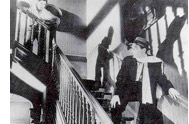 Think film noir, those dank and atmospheric 1940s crime thrillers that indelibly captured the mood of a worried and cynical postwar America, and you may be thinking Nicholas Musuraca. He’s the unsung cameraman who shot so many of those low-budget pictures for the old RKO Studios at a time when Hollywood’s dream factories specialized in conjuring up nightmares.
Think film noir, those dank and atmospheric 1940s crime thrillers that indelibly captured the mood of a worried and cynical postwar America, and you may be thinking Nicholas Musuraca. He’s the unsung cameraman who shot so many of those low-budget pictures for the old RKO Studios at a time when Hollywood’s dream factories specialized in conjuring up nightmares.
It was his lighting schemes and cinematography that so vividly captured an Expressionist underworld of harsh streetlights, rain-slicked streets and furtive figures in fedoras and trench-coats skulking through dark alleys.
Starting on Friday, May 14, the Los Angeles County Museum of Art begins Where Danger Lives: The Noir Cinematography of Nicholas Musuraca, a three-week tribute featuring some of Musuraca’s most memorable but rarely seen work. You’ll see “Stranger on the Third Floor,” considered by many to be the first genuine film noir; “Out of the Past,” starring Robert Mitchum and a young Kirk Douglas in a quintessential noir tale of a girl, a guy and a gangster trying desperately to escape the fate closing in on them; “Cat People,” an unsettling psychological thriller whose terrors lurk just outside the camera frame, and many more.
Ready to visit the dark side? First visit the LACMA website for tickets and directions. LACMA is located at 5905 Wilshire in the Miracle Mile, with easy parking in a nearby surface lot or LACMA’s new underground garage.
Posted 5-06-10
Spill, baby, spill
May 5, 2010
If you’re of a certain age, like me, you can still remember the horrifying scenes that unfolded for weeks along the Santa Barbara shoreline—the oil-drenched birds, the blackened sands, the hundreds of crews in rain slickers battling vainly against the advancing ooze.
Now, 40 years later, here we are again. Our nation’s coast is about to be assaulted once more by the failure of an offshore drilling rig, triggering the same kind of man-made mayhem that hit Santa Barbara in 1969 and that led to a series of landmark laws aimed at protecting our natural environment.
I know that four decades is a long time to hold something vividly in our memories. There is a natural tendency to forget, in the absence of catastrophe, the monumental consequences that can flow from a single mishap. This is why, in recent times, I believe there has been a softening among some policymakers of both parties towards off-shore drilling.
But the truth is that the public should expect more from those of us entrusted with protecting our eco-systems for future generations. The lessons of Santa Barbara—and those that now will be learned along the Gulf Coast—should require no remedial work. We need to ace these tests the first time or face the kind of unmitigated environmental and economic disaster that at this very moment is barreling down on the Gulf Coast states of Louisiana, Mississippi, Alabama and Florida.
 Simply put, we must stop any future consideration of off-shore drilling leases because no oil company can ever guarantee that an accident will not happen again, no matter how many rosy reports the industry churns out about the safety of such drilling.
Simply put, we must stop any future consideration of off-shore drilling leases because no oil company can ever guarantee that an accident will not happen again, no matter how many rosy reports the industry churns out about the safety of such drilling.
I applaud Gov. Arnold Schwarzenegger for recognizing that truth and reversing course yesterday in his plan for more drilling off the coast of Santa Barbara, which he had hoped would pump revenues into the state’s deficit-plagued budget. I also support President Obama’s move to halt any new off-shore leases until a complete investigation is completed of the explosion on BP’s deep-water platform in the Gulf. But I’d go a significant step further and put an end to additional off-shore drilling no matter what the circumstances surrounding the BP probe.
Our overriding public policy on this issue must be that the coastline is a resource worth protecting—one that, on balance, is of greater significance than the revenues of the oil industry or the relatively small amount of oil extracted from off-shore rigs. And I believe, from personal experience, that this is what the public wants.
Back in 1988, when I served on the Los Angeles City Council, the late-Councilman Marvin Braude and I authored a local ballot measure called Proposition O that banned drilling on land within a mile of the beach. The opposition spent huge sums in a misleading campaign to defeat our measure. Nonetheless, Prop. O passed and remains the law in the City of Los Angeles.
So now another test is upon us. Will we continue to cling to a belief that, with just a little more technological know-how, we’ll be able to safely perfect the science of ocean drilling? Or will we finally learn that now is the time to seriously move forward with the development of renewable energy sources that do not carry with them a certainty of environmental destruction?
This much I know for sure if we continue the status quo: “drill, baby, drill” inevitably will become “spill, baby, spill.”
Posted 4-4-10
Demolition time on Sunset
May 5, 2010
When the Sunset Boulevard bridge overpass to the 405 Freeway comes down, don’t expect a Vegas-style, imploding-the-Sands-Hotel kind of spectacle. This will be more of a chunk-by-chunk demolition—what one Metro official likens to taking apart a giant Lego structure.
But this is no child’s play.
The $1.034 billion I-405 Sepulveda Pass widening project enters a challenging new phase this week as workers prepare to demolish portions of the Sunset Bridge, one of three overpasses to be taken down and replaced with wider, upgraded structures in coming months. Up next are bridges at Skirball Center Drive (work slated to begin this fall) and Mulholland (scheduled to begin after the Skirball work starts.)
Although advance work on the Sunset bridge project starts Friday, the precise date for the demolition is up in the air, with the start likely to come this month, depending on how the prep work goes.
The bridge will have four lanes open to traffic during construction—two in each direction—but the prospect of the inevitable noise, dirt and traffic disruption has many in this tony neighborhood on edge. Adding to the concern is the beginning of work next week on a city Department of Water and Power water pipeline project that, for the next six months, will close a block-long stretch of Church Lane heading south from Sunset.
At the Luxe Hotel Sunset Boulevard, one of two upscale hotels located in the midst of the coming action, employees are used to staging enormous wedding and bar mitzvah receptions in the 300-guest ballroom and catering to the needs of high-profile guests reported to include celebrities such as Charlize Theron and Jennifer Love Hewitt.
But operating a hotel with two massive construction projects just outside the door?
“We are actually, honestly, scared,” says Seth Horowitz, who until recently was general manager of the Luxe, site of a community meeting earlier this week for members of local neighborhood associations seeking information on the projects. Metro representatives have met with officials of the Luxe and its nearby counterpart, Hotel Angeleno, and promised to stay in close communication to ensure that construction doesn’t interfere with upcoming big events at the hotels.
Even at the best of times, getting around the area can be tough. Horowitz said a guest at a “very important event” recently told him about battling rush hour traffic for 1-1/2 hours to reach the hotel from Paul Revere Middle School near Mandeville Canyon Road—less than three miles away. “That’s before they cut down the bridge,” Horowitz says.
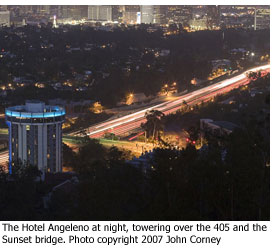 Eventually, that kind of surface street congestion should be helped by the freeway project, whose primary objective is to create a 10-mile northbound carpool lane on the 405 through the Sepulveda Pass—one of the most heavily-traveled corridors in the country. The rebuilt Sunset Bridge will be upgraded seismically and will be wider—120 feet, compared to 90 feet now—with 8 lanes instead of the current six and “higher capacity on- and off-ramps,” according to Metro.
Eventually, that kind of surface street congestion should be helped by the freeway project, whose primary objective is to create a 10-mile northbound carpool lane on the 405 through the Sepulveda Pass—one of the most heavily-traveled corridors in the country. The rebuilt Sunset Bridge will be upgraded seismically and will be wider—120 feet, compared to 90 feet now—with 8 lanes instead of the current six and “higher capacity on- and off-ramps,” according to Metro.
The new capacity could also help with concerns about freeway-bound cars backing up onto local streets. As for the long-running issue of freeway-ramp meter timing, a pilot program set to begin May 21 will examine whether turning the meters off during construction will improve traffic conditions.
Mike Barbour, Metro’s top executive on the project, acknowledges the area’s traffic congestion problems and the fact that residents will “kind of have to plan their lives around this work” for a while.” He says his agency is working to communicate alternative routes and detours, and to respond, whenever possible, to community suggestions for improving the situation. “If it becomes a complete mess out there,” he says, “obviously we’re going to correct that.”
More than anything, though, he says the goal is to get the contractor, Kiewit Pacific Co., to complete the work as quickly as possible. “Our big push is going to be to get it done sooner,” Barbour says.
In the meantime Metro has established a page dedicated to the Sunset Bridge demolition on its website and also is experimenting with an array of social media to get the word out. “I tweeted 14 times today, just because today there happened to be a lot of lane closures,” says Ned J. Racine, the project’s “new media officer.” In addition to Twitter and Facebook, the latest tool in Racine’s lineup is Nixle, an ad-free notification site used by law enforcement and other government agencies to communicate highly localized information to members of the public.
But cyber tools are not going to be enough to get the job done in the real world, even in this highly desirable corner of the real world, dotted as it is with such internationally known locales as the Getty, UCLA, Brentwood and Bel-Air. So for the demolition work, they’re bringing in a destruction tool called the “hoe ram”—a crane with a massive jackhammer attached. The contractor is “basically going to break the bridge apart with a huge jackhammer,” says Mark Van Gessel, Metro’s manager for the Sunset segment.
The work will take place in phases—between 6 and 9 nights of demolition followed by 10 months of construction on the southern end of the bridge, with a repeat of the same pattern on the northern side when the first half is finished. In all, some 12,000 tons of concrete will come down, to be pulverized onsite and recycled as “crushed miscellaneous base” and used as a building material on the project.
Segments of the freeway will be closed when demo work is taking place on the bridge overhead, as will streets including Sunset and Sepulveda. However, the work will be staggered so that the freeway and Sepulveda will not be closed at the same time.
Workers will start preparing for the job on Friday night, closing Sunset Boulevard and on-ramps near the Hotel Angeleno at 9 p.m. to establish new lane markings and a work zone to be completed by 6 a.m. Monday morning. Then they’ll start preparing the bridge for demolition: securing a major 34-inch water line inside the bridge; removing and bagging asbestos from around piping; and taking out the original wood forms so that the concrete can be recycled.
Cori Solomon, president of the Brentwood Glen Association, organized the meeting at the Luxe Hotel this week and invited her counterparts in the Westwood Hills Residents Association to take part as well. (Metro’s presentation is here, with slide 11 detailing Friday’s work.)
About 200 people showed up to voice concerns about noise, the double-whammy of the Church Lane water main work taking place at the same time the bridge job is underway, and the potential for construction to send new “cut through” traffic onto traditionally quiet residential streets.
Solomon, who’s lived in the neighborhood nearly 24 years, says her goal throughout the project is to “keep the community aware” and to find ways to make the situation “semi-livable” for residents.
“The board understands that it’s not going to be easy. It’s going to be a mess,” she says. “The thing is, it’s going to happen. You can’t stop it.”
And a philosophical attitude helps. “In the scheme of things, this freeway construction is a small speck in your life,” Solomon says. “In the end, it will hopefully be a little better, a little nicer.”
The project hotline number is (213) 922-3665. The next community meeting is scheduled for May 20, from 6-8 p.m. at The Getty. A fact sheet on the project, including a list of frequently asked questions, is here.
Posted 5-05-10




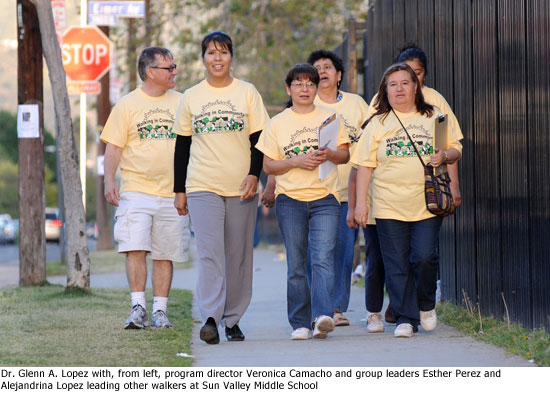

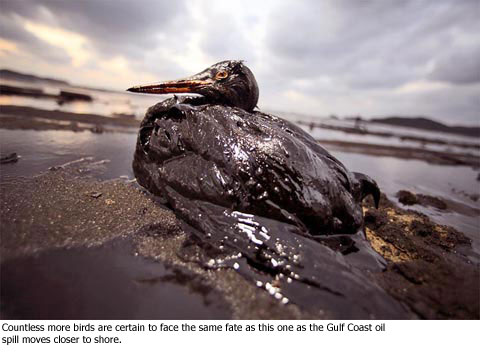
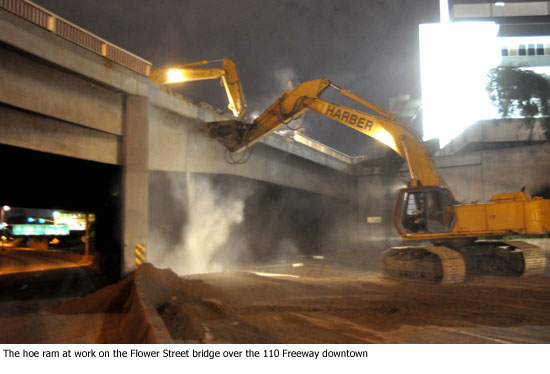
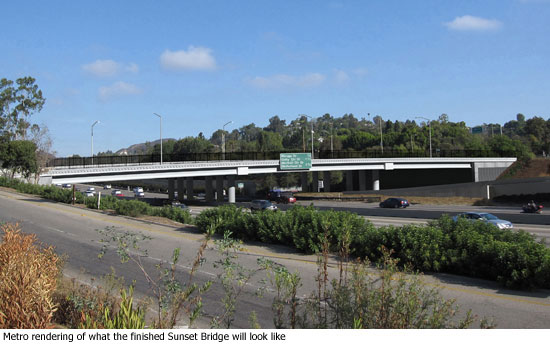





 Check for the latest closure information
Check for the latest closure information








